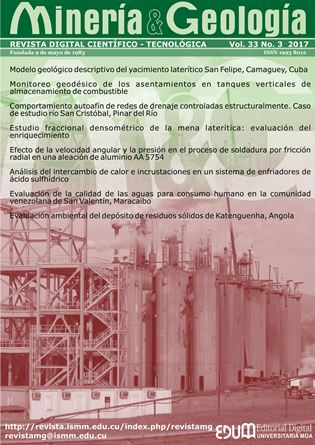Self-affine Behavior of Structurally Controlled River Networks. Case of Study San Cristóbal River, Cuba
Keywords:
river of San Cristóbal, fractal, lacunarity, hurst, self-affineAbstract
Geological structure influences the form, length and slope of rivers. An approach never used in the area is the fractal analysis for river networks, which allowed to describe and quantify the complexity of this network and associate it to geological structures and faults in the area. Self-similar fractal analysis allowed to prove the unequal river network development in longitudinal and transversal directions. The average fractal value, under self-similarity assumption, is 1,04, indicating the prevalence of straight superficial currents, tectonically controlled, while the river network fractal dimension takes values of 1,59 and 1,47. Under assumptions of self-affinity, the lacunarity dimension takes the value of 1,86 and the Hurst coefficient is 0,86, indicating the structural control on drainage. The main rivers directions coincide with zones of geological weaknesses, originated during the overthrust event, or secondary Riedel fractures related to the left-lateral movement of Pinar fault.Downloads
References
COBIELLA-REGUERA, J. L. 2008: Reconstrucción palinspástica del paleomargen mesozoico de América del Norte en Cuba occidental y el sudeste del Golfo de México. Implicaciones para la evolución del SE del Golfo de México. Revista Mexicana de Ciencias Geológicas 25(3): 382-401.
COFIÑO, C. E. & CÁCERES, D. 2003: Efectividad de la utilización de métodos microtectónicos en el desciframiento de la evolución de estructuras tectónicas (Falla Pinar). Minería y Geología 19(3-4): 29-34.
HACK, J. T. 1957: Studies of longitudinal stream profiles in Virginia and Maryland. U.S. Geological Survey, Professional Paper 294: 45-97.
HACK, J.T. 1973: Stream-profile analysis and stream-gradient index. U.S. Geological Survey, Journal Research, 1(4): 421-429.
HORTON, R. E. 1932: Drainage basin characteristics. Transactions American Geophysical Union 13(1): 350-361.
HORTON, R. E. 1945: Erosional development of streams and their drainage basins: hydrophysical approach to quantitative morphology. Geological Society America Bulletin 56(3): 275-370.
KIRCHNER, J.W. 1993: Statistical inevitability of Horton's laws and the apparent randomness of stream channel networks. Geology, 21: 521-594.
LA BARBERA, P., ROSSO, R. 1989: On the fractal dimension of stream networks. Water Resources Research, 25(4): 735-741.
LA BARBERA, P. & ROSSO, R. 1990: Reply. Water Resources Research 26(9): 2245–2248.
LIU, T. 1992: Fractal structure and properties of stream networks. Water Resources Research 28(11): 2981-2988.
MANDELBROT, B. B. 1977: Fractals, form, chance and dimension. W. W. Freeman and Company, San Francisco.
MANDELBROT, B.B. 1986: Self-affine fractal sets. En: Pietronero, L., Tosatti, E. (Eds.), Fractals in Physics. North-Holland, Amsterdam.
NIKORA, V. I. & SAPOZHNIKOV, V. B. 1993: River network fractal geometry and its computer simulation. Water Resources Research 29(10): 3569-3575.
NIKORA, V.; IBBITT, R. & SHANKAR, U. 1996: On channel network fractal properties: A case of study of the Hutt River basin, New Zealand. Water Resources Research 32(11): 3375-3384.
ORDAZ A., HERNÁNDEZ-SANTANA, J.R., COFIÑO, C.E., MÉNDEZ, A.P., GALAZ, G. 2013: Análisis estructural y morfotectónico en los municipios San Cristóbal y Candelaria, Cuba Occidental: contribución a los estudios de peligrosidad sísmica de la falla Pinar. Investigaciones Geográficas, Boletín del Instituto de Geografía, UNAM, (82): 7-23.
ORDAZ, A. 2013: Evaluación de las condiciones ingeniero-geológicas para el pronóstico de la respuesta dinámica de los suelos. Caso de estudio: Ciudad de San Cristóbal, Cuba occidental. Tesis de doctorado. Universidad de Pinar del Río.
RODRÍGUEZ-ITURBE, I., RINALDO, A., RIGON, R., BRAS, R.L., MARANI, A., IJJÁSZ-VÁSQUEZ, E. 1991: Energy dissipation, runoff production, and the three-dimensional structure of river basins. Water Resources Research, 28(4): 1095-1103.
ROSSO, R.; BACCHI, B. & LA BARBERA, P. 1991: Fractal relation of mainstream length to catchment area in river networks. Water Resources Research 27(3): 381-387.
SCHULLER, D.J., RAO, A.R., JEONG, G.D. 2001: Fractal characteristics of dense stream networks. Journal of Hydrology, 243: 1–16
SCHUMM, S. A. 1956: Evolution of drainage systems and slopes in badlands at Perth Amboy, New Jersey. Geological Society of America Bulletin, 67: 597-646.
STRAHLER, A. N. 1946: Elongate intrenched meanders of Conodoguinet Creek. American Journal of Science 244(1): 31-40.
STRAHLER, A.N., 1952. Dynamic basis of geomorphology. Geological Society of America Bulletin, 63: 923–938.
TAKAYASU, H. 1990: Fractals in the physical sciences. Manchester University Press, Manchester.
TARBOTON, D. G. 1996: Fractal river networks, Horton's laws and Tokunaga cyclicity. Journal of Hydrology 187(1-2): 105-117.
Published
How to Cite
Issue
Section
Copyright (c) 2017 Robert Ramírez-Hernández, Dámaso Cáceres-Govea

This work is licensed under a Creative Commons Attribution-NonCommercial 4.0 International License.
- Authors retain copyright and guaranteeing the right magazine to be the first publication of the work as licensed under a Creative Commons Attribution-NonCommercial that allows others to share the work with an acknowledgment of the work's authorship and initial publication in this journal.
- Authors may establish separate supplemental agreements for the exclusive distribution version of the work published in the journal (eg, place it in an institutional repository or publish it in a book), with an acknowledgment of its initial publication in this journal.
- Authors are allowed and recommended to disseminate their work through the Internet (e.g., in institutional telematic archives or on their websites) before and during the submission process, which can produce interesting exchanges and increase citations of the published work. (See The effect of open access)










